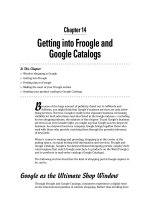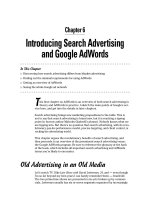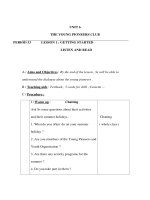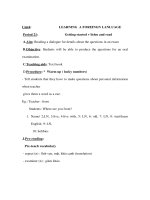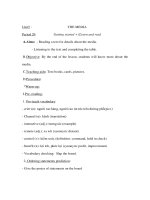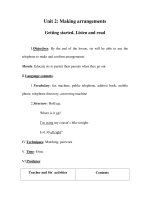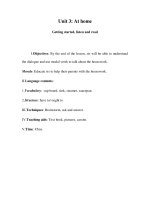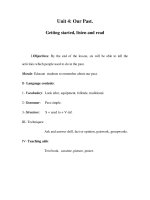Getting into Froogle and Google Catalogs
Bạn đang xem bản rút gọn của tài liệu. Xem và tải ngay bản đầy đủ của tài liệu tại đây (667.98 KB, 14 trang )
Chapter 14
Getting into Froogle and
Google Catalogs
In This Chapter
ᮣ
Window shopping in Google
ᮣ
Getting into Froogle
ᮣ
Feeding data to Froogle
ᮣ
Making the most of your Froogle entries
ᮣ
Sending your product catalog to Google Catalogs
B
ecause of the huge amount of publicity doled out to AdWords and
AdSense, you might think that Google’s business services are only adver-
tising services. Not true. Google is really in the exposure business, increasing
visibility for both advertisers and sites listed in the Google indexes — including
its two shopping indexes, the subjects of this chapter. To put Google’s business
services in an even broader light, you might say that Google is in the keyword
business. As a keyword services company, Google brings together those who
seek with those who provide, matching them through the powerful relevancy
of keywords.
When it comes to seeking and providing, shopping is at the center of the
mating dance, on equal footing with information and services. Froogle and
Google Catalogs, Google’s two keyword-based shopping portals, employ dedi-
cated engines that match Google searchers to products on the Web (Froogle)
and to products in mail-order catalogs (Google Catalogs).
The following section describes the kind of shopping portal Google aspires to
be, and is.
Google as the Ultimate Shop Window
Through Froogle and Google Catalogs, consumers experience a digital twist
on the time-honored pastime of window shopping. Rather than strolling from
21_571435 ch14.qxd 5/21/04 11:40 PM Page 257
window to window, consumers gaze through the single Google window as its
contents change on demand.
Froogle and Google Catalogs are hybrid directories/engines that respond to
keyword searches. The main difference between Google’s shopping services
and those in other major portals is that Google doesn’t get its hands on the
money. Customers don’t buy anything through Google. Both Froogle and
Google Catalogs function purely as directories to products, sending consumers
elsewhere to make their purchases.
Following are two important points for merchants:
ߜ Google has no revenue-sharing arrangement with any merchant repre-
sented in either Froogle or Google Catalogs.
ߜ Preferred placement in the search results for Froogle or Google Catalogs
is not available.
Although you can’t buy your way to the top of a Froogle or Google Catalogs
search results page, Google does place AdWords ads on Froogle pages. Froogle
ads might be the most powerful possible deployment of a product-oriented
AdWords campaign because those ads share the page not with information
links (as is likely on a Google search page), but with product links. Essentially,
every link on a Froogle page is an ad, so AdWords ads don’t stand out as ads
to the same extent as on any other page.
If you’re a merchant who wants to extend your AdWords campaign to Froogle,
you need only set your ads to appear in Google’s network of search sites, in
the Campaign settings of your AdWords account (see Chapter 7). However,
you can’t limit your ads to Froogle pages — you must accept AdWords distri-
bution throughout Google search pages. (See Chapters 6 through 10 for an
extensive discussion of AdWords.)
Google doesn’t assist you in setting up an e-commerce shop or transacting
business. Compare this approach to Yahoo! Shopping, which is a virtual mall
where any merchant can rent space. Yahoo! helps design and implement the
online store and offers extensive transaction services, including a universal
shopping cart and easy payment-data collection through Yahoo! Wallet. Ban-
ners of featured stores clutter the main pages. The underlying search engine
has some smarts. All this is useful, and Yahoo! houses many of the most impor-
tant online retailers in the business. AOL and MSN have similar programs.
You may operate your online store at Yahoo! Store (or in AOL or MSN) and still
be represented in Froogle and in Google Catalogs. In fact, many Yahoo! Stores
are included in Froogle thanks to a Yahoo! setting that makes the store’s prod-
ucts compatible with Froogle’s crawler. (The setting turns Yahoo! Store prod-
uct information into something similar to a Froogle data feed, which I describe
258
Part IV: Google Business for the Larger Company
21_571435 ch14.qxd 5/21/04 11:40 PM Page 258
in the next section.) Besides the Yahoo! Store quirk, Google is store-agnostic;
it doesn’t care where you’re located or who handles your transactions.
Systems like Yahoo!’s and AOL’s, modeled on shopping malls, are purchase
oriented. Google is search oriented. Google is not currently interested in sell-
ing products directly, taking payment information, or hosting stores. There’s
no Google Wallet.
The Google shopping portal is a search engine that separates products from
stores to deliver targeted search lists. Furthermore, it uses evaluations simi-
lar to those in a Web search to determine which products matching your
keywords are most important and should be listed first. Froogle and Google
Catalogs recognize merchant branding but downplay it. The product is far
more important than the store, because Google recognizes that priority in the
minds of most shoppers. The pages of Froogle and Google Catalogs are as
banner-free as all other Google pages, as you can see in Figures 14-1 and 14-2.
When it comes to buying through Google, through is the right word, as opposed
to from. Froogle search results are like Web search results, insofar as they link
you to target sites, in this case e-commerce sites with their own shopping carts
and payment systems. Google Catalogs provides mail-order phone numbers
and — where possible — links to Web sites.
Figure 14-1:
Froogle
search
results and
AdWords
ads.
259
Chapter 14: Getting into Froogle and Google Catalogs
21_571435 ch14.qxd 5/21/04 11:40 PM Page 259
Understanding Froogle’s Index
and Search Results
Getting into Froogle resembles getting into Google’s Web index. Two methods
are at your disposal:
ߜ Let Froogle find your products
ߜ Submit your products to Froogle
Submitting to Froogle is a more complicated affair than submitting a site URL
to Google’s Web index and requires a familiarity with database files. More on
that a bit later.
Being crawled by Froogle
Froogle’s strength, like that of Google’s flagship service, lies in its crawling and
ranking engine. This dedicated engine crawls deeply through the Web, as
Google’s Web spider does, and uses contextual analysis to find product pages.
From those pages Froogle extracts categories of information — product type,
Figure 14-2:
Catalogs
search
results.
260
Part IV: Google Business for the Larger Company
21_571435 ch14.qxd 5/21/04 11:40 PM Page 260
name, description, price, and a photograph if there is one. Then Froogle ranks
the page, places the product into a category of the Froogle directory, associ-
ates the page with keywords, and incorporates all this in its index. When a
consumer searches Froogle by keyword, the crawled product appears in the
results list according to its rank and relevancy.
Most of this index-building works remarkably well. Froogle is good at recog-
nizing products and e-commerce pages in the colossal mass of Web content
that it sifts through. If your product pages contain standard indicators of
e-commerce, such as prices, references to a shopping cart, and product
descriptions, Froogle can identify those pages as relevant to its mission and
extract the information more or less accurately.
Will Froogle find the pages in the first place? Your visibility to Froogle is based
on the same principles as your visibility to Google’s Web index: Primarily, you
must be linked to be found. Froogle finds products the same way Google’s
engines find anything — by crawling links. At least one link to your product
page must exist, somewhere, for Google to make the connection. That link can
come from your own site, as long as that site is represented in Google’s Web
index. If Google knows about you in the Web index, Froogle knows you exist
also, and can put your products in the Froogle index.
Search results in Froogle
Froogle’s search results are delivered in two categories:
ߜ Confirmed results
ߜ Total results
For the most part, confirmed results are submitted products. The rest of the
total results (which I call unconfirmed results, but Froogle doesn’t call any-
thing) consist of product information extracted from the Web and assembled
by Froogle’s spider. Confirmed results are distinguished by three important
features that merchants should be aware of:
ߜ Confirmed results always appear first, above the unconfirmed results
(refer to Figure 14-1).
ߜ Confirmed results always include the store name.
ߜ Confirmed results are always accurate, to the degree that they are sub-
mitted accurately. Unconfirmed results might be accurate too, but the
merchant has only indirect control over their accuracy.
The separation of confirmed results from total results is a relatively new
Froogle feature, and it puts pressure on merchants to submit their products
lest they be dropped lower on the results list. The next section discusses the
Froogle data feed by which products are submitted.
261
Chapter 14: Getting into Froogle and Google Catalogs
21_571435 ch14.qxd 5/21/04 11:40 PM Page 261
